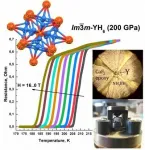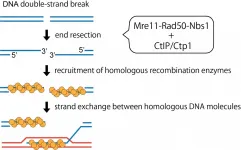(Press-News.org) Computer engineers at the world's largest companies and universities are using machines to scan through tomes of written material. The goal? Teach these machines the gift of language. Do that, some even claim, and computers will be able to mimic the human brain.
But this impressive compute capability comes with real costs, including perpetuating racism and causing significant environmental damage, according to a new paper, "On the Dangers of Stochastic Parrots: Can Language Models Be Too Big? ?" The paper is being presented Wednesday, March 10 at the ACM Conference on Fairness, Accountability and Transparency (ACM FAccT).
This is the first exhaustive review of the literature surrounding the risks that come with rapid growth of language-learning technologies, said Emily M. Bender, a University of Washington professor of linguistics and a lead author of the paper along with Timnit Gebru, a well-known AI researcher.
"The question we're asking is what are the possible dangers of this approach and the answers that we're giving involve surveying literature across a broad range of fields and pulling them together," said Bender, who is the UW Howard and Frances Nostrand Endowed Professor.
What the researchers surfaced was that there are downsides to the ever-growing computing power put into natural language models. They discuss how the ever-increasing size of training data for language modeling exacerbates social and environmental issues. Alarmingly, such language models perpetuate hegemonic language and can deceive people into thinking they are having a "real" conversation with a person rather than a machine. The increased computational needs of these models further contributes to environmental degradation.
The authors were motivated to write the paper because of a trend within the field towards ever-larger language models and their growing spheres of influence.
The paper already has generated wide-spread attention due, in part, to the fact that two of the paper's co-authors say they were fired recently from Google for reasons that remain unsettled. Margaret Mitchell and Gebru, the two now-former Google researchers, said they stand by the paper's scholarship and point to its conclusions as a clarion call to industry to take heed.
"It's very clear that putting in the concerns has to happen right now, because it's already becoming too late," said Mitchell, a researcher in AI.
It takes an enormous amount of computing power to fuel the model language programs, Bender said. That takes up energy at tremendous scale, and that, the authors argue, causes environmental degradation. And those costs aren't borne by the computer engineers, but rather by marginalized people who cannot afford the environmental costs.
"It's not just that there's big energy impacts here, but also that the carbon impacts of that will bring costs first to people who are not benefiting from this technology," Bender said. "When we do the cost-benefit analysis, it's important to think of who's getting the benefit and who's paying the cost because they're not the same people."
The large scale of this compute power also can restrict access to only the most well-resourced companies and research groups, leaving out smaller developers outside of the U.S., Canada, Europe and China. That's because it takes huge machines to run the software necessary to make computers mimic human thought and speech.
Another risk comes from the training data itself, the authors say. Because the computers read language from the Web and from other sources, they can pick up and perpetuate racist, sexist, ableist, extremist and other harmful ideologies.
"One of the fallacies that people fall into is well, the internet is big, the internet is everything. If I just scrape the whole internet then clearly I've incorporated diverse viewpoints," Bender said. "But when we did a step-by-step review of the literature, it says that's not the case right now because not everybody's on the internet, and of the people who are on the internet, not everybody is socially comfortable participating in the same way."
And, people can confuse the language models for real human interaction, believing that they're actually talking with a person or reading something that a person has spoken or written, when, in fact, the language comes from a machine. Thus, the stochastic parrots.
"It produces this seemingly coherent text, but it has no communicative intent. It has no idea what it's saying. There's no there there," Bender said.
INFORMATION:
Angelina McMillan-Major, a doctoral student in linguistics at UW, also co-authored the paper.
Effective, specific, with a reversible and non-harmful action: the identikit of the perfect biomaterial seems to correspond to graphene flakes, the subject of a new study carried out by SISSA - International School for Advanced Studies of Trieste, Catalan Institute of Nanoscience and Nanotechnology (ICN2) of Barcelona and the National Graphene Institute of the University of Manchester, in the framework of the European Graphene Flagship project. This nanomaterial has demonstrated the ability to interact with the functions of the nervous system in vertebrates in a very specific manner, interrupting the building up of a pathological process that leads ...
Healthcare personnel who were infected with COVID-19 had stronger risk factors outside the workplace than in their hospital or healthcare setting. That is the finding of a new study published today in JAMA Network Open conducted by University of Maryland School of Medicine (UMSOM) researchers, colleagues at the Centers for Disease Control and Prevention (CDC) and three other universities.
The study examined survey data from nearly 25,000 healthcare providers in Baltimore, Atlanta, and Chicago including at University of Maryland Medical System (UMMS) hospitals. They found that having a known exposure to someone who tested positive for COVID-19 in the community was the strongest risk factor for testing ...
An international team led by Artem R. Oganov, a Professor at Skoltech and MISIS, and Dr. Ivan Troyan from the Institute of Crystallography of RAS performed theoretical and experimental research on a new high-temperature superconductor, yttrium hydride (YH6). Their findings were published in the journal Advanced Materials.
Yttrium hydrides rank among the three highest-temperature superconductors known to date. The leader among the three is a material with an unknown S-C-H composition and superconductivity at 288 K, which is followed by lanthanum hydride, LaH10, superconducting at temperatures up to 259 K), and, finally, yttrium hydrides, YH6 and YH9, with maximum superconductivity temperatures of 224 K and 243 K, respectively. The superconductivity of YH6 ...
Boston - A new study shows that providing a non-acute care space after hospital discharge for patients with COVID-19 who are experiencing homelessness helped reduce hospitalizations and keep inpatient beds available for those requiring acute care. Published in JAMA Network Open and led by researchers at Boston Medical Center's (BMC) Grayken Center for Addiction, the study demonstrates the importance of developing innovative approaches to tackle issues facing people experiencing homelessness, including their inability to isolate, in order to mitigate additional ...
Associations between strong predictors of suicidal behaviors over the life course, such as adverse childhood events (ACEs), remain understudied among youth of color. Although not previously considered high risk, suicide attempts among Black youth increased 73% between 1991 and 2017.
Published in the Children and Youth Services Review, University of Minnesota researchers pulled data from the 2016 Minnesota Student Survey (MSS) to examine associations between ACEs, school connectedness and suicide ideation and attempts among Somali, Latino, Hmong and Non-Hispanic ...
Research published in Environmental Toxicology and Chemistry shows that the presence of polybrominated diphenyl ethers (PBDEs) in bald eagle populations is slowly declining. Bald eagles are apex predators that nest and, more importantly, feed along water bodies, making them excellent bioindicators of environmental contaminants that bioaccumulate up the aquatic food web. The findings are both good news for eagles and instructive for regulators tasked with managing surface water quality by setting protective levels for wildlife, as well as fish consumption advisories for humans.
Lead author Bill Route from the National ...
Scientists at Tokyo Institute of Technology (Tokyo Tech) have uncovered mechanisms underlying the activation of the MRN complex-- the cell's DNA scissors. Using purified yeast proteins, they demonstrated that phosphorylation of Ctp1, a homolog of a tumor-suppressor protein, plays a key role in activating MRN complex's DNA clipping activity. Intriguingly, a short segment of yeast Ctp1 or its human counterpart could stimulate endonuclease activity of their respective MRN complexes, suggesting its conserved function across species.
DNA functions as a roadmap that guides the identity and functions of cells. A glitch in the DNA ...
BINGHAMTON, NY -- Star employees often get most of the credit when things go right, but also shoulder most of the blame when things go wrong, according to new research from Binghamton University, State University of New York.
The study explored the potential risks and rewards of collaborating with stars - individuals who have a reputation for exhibiting exceptional performance - and how individual performance factors into how much credit and blame is shared with collaborators.
"Stars are human, and they fail from time to time. We wanted to shift the focus away from stars, and find out what happens to the people who collaborate ...
ALBUQUERQUE, N.M. -- Geoscientists at Sandia National Laboratories used 3D-printed rocks and an advanced, large-scale computer model of past earthquakes to understand and prevent earthquakes triggered by energy exploration.
Injecting water underground after unconventional oil and gas extraction, commonly known as fracking, geothermal energy stimulation and carbon dioxide sequestration all can trigger earthquakes. Of course, energy companies do their due diligence to check for faults -- breaks in the earth's upper crust that are prone to earthquakes -- but sometimes ...
Eye contact is a key to establishing a connection, and teachers use it often to encourage participation. But can a robot do this too? Can it draw a response simply by making "eye" contact, even with people who are less inclined to speak up. A recent study suggests that it can.
Researchers at KTH Royal Institute of Technology published results of experiments in which robots led a Swedish word game with individuals whose proficiency in the Nordic language was varied. They found that by redirecting its gaze to less proficient players, a robot can elicit involvement from even the most reluctant participants.
Researchers Sarah Gillet and Ronald Cumbal say the results offer evidence that robots could play a productive role in educational settings.
Calling on someone by name isn't ...


